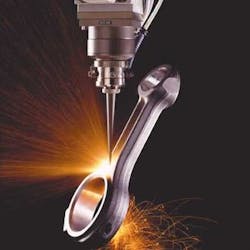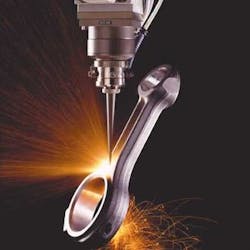Drilling with light
The combination of precision, durability, and flexibility makes laser drilling a process of choice for industries such as aerospace and automotive
Laser material processing is distinctive because of its high flexibility and good automation potential, attributes that also apply to drilling with the laser. Because of the non-contact nature of the process, the main advantage is the lack of wear and tear on the "drilling tool," as well as the fact that it cannot break. Laser drilling of hard materials—even for diameters less than 2 mm—can thus be utilized efficiently in production.
Drilling holes at shallow angles to the surface is another laser advantage. Holes with an angle of roughly 20° to the surface of the component can also be created via electrical discharge machining, or EDM. However, the EDM process is slower than laser drilling, which is why the method is only beneficial when several drill holes have to be simultaneously produced in one component.
Precision drilling with pulsed Nd:YAG lasers enables hole diameters of approximately 50 µm to be produced, depending on the drilling method, laser properties, and drilling depth. In precision drilling, typical hole diameters are between 60 µm and 150 µm at drill depths of from 0.3 mm to 1 mm. In this range, precision-drilled holes are used in filters and sieves for fuel lines and injection modules. Drilled holes in fuel-feed throttle elements and in hydraulic modules in general can also be produced.
On the whole, laser drilling is optimal at drill depths up to 30 mm, depending on the laser properties and hole diameters up to 2 mm.
Typical applications for laser drilling in the automotive industry include oil-hole and low-temperature drilling in high-tensile or hardened materials in engines and gearboxes, such as rocker arms and levers, connecting rods, crankcases, cylinder heads, shafts, and other components.
Today these drill holes are largely drilled mechanically or with EDM. Mechanical drilling is fast, but components destined for hardening have to be drilled before heat treatment. Furthermore, the required drill depths of between 8 mm and 20 mm with diameters of 0.8 mm can either not be produced at all or only with minimal processing safety (drill breakage). Angled drill-holes are a challenge for mechanical drilling. EDM does produce the required diameters and depths without a problem, but the drilling times are in the minute range. Figure 1 shows a cross-section of an oil-hole inside a camshaft. As with turbine-drilled holes on turbine components, recast thickness has to be kept shallow because it can harden up to 980 HV.
For the past 20 years, the aerospace industry has used lasers to drill cooling holes in turbine blades and combustion chamber panels. Because of steadily increasing demands for improved efficiency, turbines are operated at temperatures that are partially above the melting points of the materials used. For this reason, a large number of cooling holes are drilled into the components with typical diameters between 0.3 mm and 0.9 mm depending on the component. The recast left behind on the hole walls is significant because it can cause cracks, which can reach as far as the basic material. Its thickness is generally limited to a maximum of 100 µm.
Ceramic layers are increasingly being added to turbine components as operating temperature limits are increased. During laser drilling, the challenge is to drill through the ceramic layer without creating cracks between the ceramic layer and the basic material. An optional change of pulse energy during hole drilling, with lasers such as the HL 101 P and HL 201 P from TRUMPF, is a perfect way of avoiding cracks of this kind. With these lasers, and a technique called "soft start," a small amount of pulse energy is used to remove the ceramic layer around the hole, and then the pulse energy is increased and the hole quickly drilled. Figure 2 shows a hole drilled in a turbine blade where the recast on the drill-hole walls is 53-µm thick. Tests have shown that melt thicknesses of between 15 µm and 30 µm are possible.
Laser drilling can be divided into single-pulse, percussion, trepanning, and helical drilling. Single-pulse drilling is used to produce a large number of holes, for example, those in filters. These holes are produced on the fly—that is, the workpiece is continually moved, even during drilling, eliminating positioning times.
Higher hole qualities are achieved with percussion drilling than with single-pulse drilling. This method enables smaller hole diameters to be produced because of the lower pulse energy. The smallest diameters are between 40 µm and 60 µm depending on drilling depth and material. With turbine applications, percussion drilling is utilized for hole diameters between 0.3 mm and 0.9 mm and drill depths up to 20 mm.
Trepanning or helical drilling are methods used for applications that place the highest demands on hole geometry. With trepanning, a hole is first percussion drilled and then the final hole diameter is cut out. With helical drilling, material is removed from the hole layer by layer, with the laser beam (or workpiece) moved in a circular fashion. The achievable hole diameters are thus larger than with percussion drilling and are distinctive for their high degree of roundness with the tolerances largely determined by the motion system. The maximum drilling depth with this method is about the same as that achieved with percussion drilling.
Laser beam parameters have a great influence on the geometry and quality of the drilling application. Beam parameters include intensity distribution, beam roundness, homogeneity of intensity distribution, and beam quality, which is determined by the beam parameter product.
TRUMPF Laser offers two units that are especially suited to drilling and precision cutting: the HL 101 P and the HL 201 P. These feature short pulses, steep pulse increases, and high peak-pulse performance, as well as high pulse-to-pulse stability and a top-hat profile that guarantees sharp cut edges and drill-hole edges. The stability of all beam parameters guarantees constant processing results. Their high pulse stability is also economical because each pulse is a working pulse. Beam parameter products remain constant across the entire pulse energy range so that when a hole is drilled, changing the energy from pulse to pulse can optimize the drilling application according to requirements.
Dr. Christof Lehner is head of sales, low-power lasers, at TRUMPF Laser GmbH + Co. KG in Schramberg. Contact him by e-mail at [email protected]



